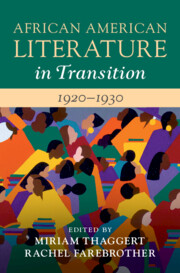Book contents
- African American Literature in Transition, 1920–1930
- African American Literature in Transition
- African American Literature in Transition, 1920–1930
- Copyright page
- Contents
- Illustrations
- Contributors
- Acknowledgments
- Chronology of Historical Events, People, and Publications, 1920–1930
- Preface
- Introduction
- Part I Habitus, Sound, Fashion
- Part II Space
- Part III Uplift Renewed
- Part IV Serial Reading
- Bibliography
- Index
Introduction
Expecting More: African American Literature in Transition, 1920–1930
Published online by Cambridge University Press: 17 March 2022
- African American Literature in Transition, 1920–1930
- African American Literature in Transition
- African American Literature in Transition, 1920–1930
- Copyright page
- Contents
- Illustrations
- Contributors
- Acknowledgments
- Chronology of Historical Events, People, and Publications, 1920–1930
- Preface
- Introduction
- Part I Habitus, Sound, Fashion
- Part II Space
- Part III Uplift Renewed
- Part IV Serial Reading
- Bibliography
- Index
Summary
The Chicago Defender began the year 1920 by presenting a startling headline to its readers: “Nine Ex-Soldiers Lynched.” The paper protested the wave of anti-Black violence that took place the preceding year and highlighted the soldiers who, after fighting for the United States during World War I, were “assassinated on [their] return to [the] land of democracy.” The editors noted that, despite the increase in violence, a sense of possibility was invading Black communities across the nation. They briefly considered a word then being readily attached to African Americans before determining that the term was inaccurate: “‘new’ is a misnomer; the better word is ‘awakened.’ 1919 has given us much for which we are thankful; we are expecting more of 1920.”
- Type
- Chapter
- Information
- African American Literature in Transition, 1920–1930 , pp. 1 - 10Publisher: Cambridge University PressPrint publication year: 2022

